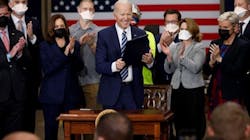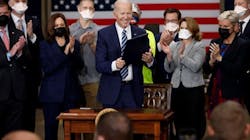The federal government is in the home stretch in its rulemaking for a 2022 executive action requiring project labor agreements (PLAs) on many federal construction projects.
The executive order issued last February by President Biden to mostly require labor union-oriented PLAs on projects exceeding $35 million has been under review by the government’s Federal Acquisition Regulatory (FAR) Council since a prolific comment period closed in October. Several target dates for the formal issuance of the final rule have come and gone since; the current one is mid-May.
While the final rule is not expected to stray far from the preliminary one that has been guiding plans for future federal contracts since the order’s issuance, the delay could signal some divergence. James Terry, partner at the New York construction law firm Zetlin & De Chiara LLP and an authority on PLAs, says the “longer than anticipated” delay might mean the council will make changes that address criticisms rule opponents have leveled about the fairness and workability of both the order and PLAs generally.
Led largely by non-union construction contractors through groups like Associated Builders and Contractors (ABC), the opposition claims the order discriminates against non-union companies with far-reaching negative consequences for industry and government. And it is rallying around the Fair and Open Competition Act, legislation introduced in Congress that would effectively roll back Biden’s executive order. Though doomed to a veto if passed, the bill stakes out anti-PLA, anti-order ground.
“The final rule – the way in which it will be implemented – will be important,” Terry says. “If it comes down with a less autocratic feel and opens the door to (federal) agencies not always having to go the PLA route that might have the effect of tamping it down some and responding to issues raised in the Fair and Open Competition Act.”
Though the order breaks new ground by broadly requiring PLAs on qualifying federal work, uniting contractors and labor organizations under a detailed set of project terms and conditions, its preliminary rules make exceptions to the requirement. They include if a PLA can be shown to be a barrier to sufficient bids; not advance economy and efficiency in federal procurement; or conflict with other statutes and regulations.
“There are provisions for exempting projects under certain circumstances, such as when a market survey finds a possible adverse impact on competition, or maybe where there’s only a trade or two involved in a project,” Terry says. “While the order ratchets up PLA requirements it has a substantial list of means by which bidders can try to establish that a project is not a PLA candidate. The devil is in the details.”
What will ultimately matter for construction contractors is whether the work is a fit for them, since PLAs will surely be much more the rule in big federal projects. Status as a union or non-union employer is a prime consideration, but others will come into play. Issues include comfort with more rules and provisions, working with other trades and unions, negotiating PLA-specifics in contracts, and understanding a new set of risks.
“It’s going to be different,” Terry says. “You’ll have to work with trades councils and individual unions, but a lot of PLAs are centrally negotiated, which can make life easier for everyone. A contractor will have to take into account the effort required to get all of these things done.”
Deeply familiar with PLAs and a believer in their value, Terry says their pros include certainty, predictability, safety, and quality, features ABC and groups like Independent Electrical Contractors Association dispute or counter with drawbacks. When the dust settles, Terry sees contractors of all types largely adapting to the new rule, projects largely benefitting, and unions emerging stronger, a byproduct sought by the Biden administration.
“If companies want a bite of this federal market they’re going to have bite the bullet on PLAs,” he says. “The question is how bad a taste that’s going to leave in their mouths. There may even be some ABC companies taking their pencils out on projects of brief duration and seeing if it’s worth crossing over.”
For more EC&M coverage of the status of federal PLAs, check out Tom Zind’s article “No Agreement On Project Labor Agreement Order.”
Tom Zind is an independent analyst and freelance writer based in Lees Summit, Mo. He can be reached at [email protected].
About the Author
Tom Zind
Freelance Writer
Zind is a freelance writer based in Lee’s Summit, Mo. He can be reached at [email protected].


